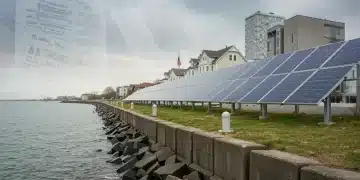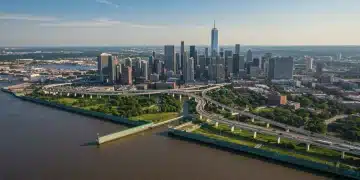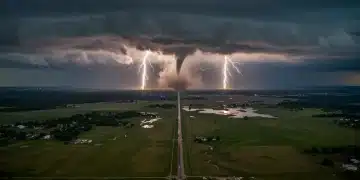Extreme Weather Impact: US Faces $100 Billion Damages in 2025
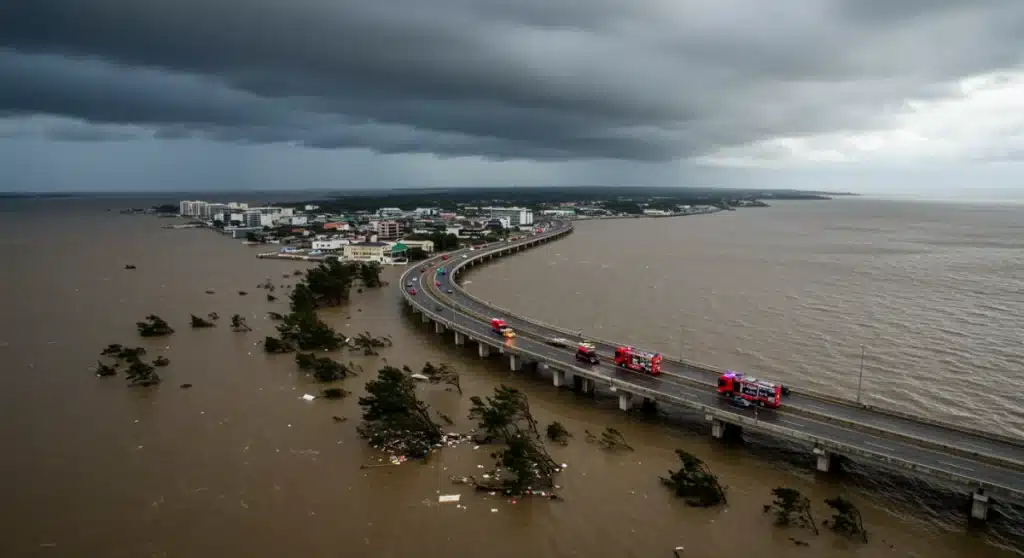
The US is projected to face $100 billion in damages from extreme weather in 2025, highlighting escalating risks to infrastructure, agriculture, and public finances and underscoring the urgent need for robust climate adaptation strategies.
The Economic Impact of Extreme Weather: $100 Billion in Damages Expected for the US in 2025 is not merely a forecast; it represents a critical warning sign for the nation’s economic stability and public safety. This projection, based on current climate trends and predictive models, demands immediate attention and proactive measures from policymakers, businesses, and communities across the United States.
Understanding the Escalating Costs of Extreme Weather
The financial toll of extreme weather events has been steadily climbing, with 2025 set to mark a significant milestone if current trends persist. This increase is driven by a confluence of factors, including rising global temperatures, changing precipitation patterns, and growing populations in vulnerable areas. The $100 billion figure encompasses direct damages to property and infrastructure, as well as indirect costs such as business interruption, supply chain disruptions, and long-term health impacts.
Several types of extreme weather contribute significantly to these escalating costs. Hurricanes and tropical storms, particularly those impacting coastal regions, routinely cause billions in damages. Wildfires, especially prevalent in the western United States, destroy homes, forests, and critical infrastructure, while also posing severe health risks due to air quality degradation. Inland flooding, often exacerbated by intense rainfall events, devastates agricultural lands and urban centers.
Key Drivers of Increasing Damage Costs
- Climate Change Acceleration: The intensification of global warming leads to more frequent and severe weather phenomena.
- Vulnerable Infrastructure: Much of the existing infrastructure in the US was not built to withstand the intensity of today’s extreme weather.
- Population Growth in Risky Areas: More people are moving into coastal zones and wildfire-prone regions, increasing exposure to hazards.
- Underinvestment in Resilience: A historical lack of significant investment in climate adaptation and resilient infrastructure has left many communities unprepared.
The convergence of these drivers creates a challenging scenario, making the projected $100 billion in damages a stark reality rather than a speculative estimate. Understanding these underlying causes is the first step toward developing effective mitigation and adaptation strategies.
Direct Economic Impacts Across Sectors
The projected damages extend far beyond immediate repair costs, permeating various sectors of the US economy. Agriculture, a cornerstone of the nation’s food supply, is particularly vulnerable to droughts, floods, and unseasonal temperature swings that disrupt crop cycles and livestock production. Energy infrastructure, including power grids and fuel pipelines, faces threats from severe storms and heatwaves, leading to widespread outages and economic losses.
Real estate and insurance markets are also feeling the brunt of these changes. Property values in high-risk zones are becoming increasingly volatile, and insurance premiums are soaring, sometimes making coverage unaffordable or unavailable. This shift places a significant burden on homeowners and businesses, potentially leading to increased uninsured losses and greater financial instability.
Moreover, the manufacturing and transportation sectors experience significant disruptions. Factories can be shut down due to power outages or damaged facilities, while roads, bridges, and rail lines become impassable, hindering the movement of goods and services. These disruptions ripple through supply chains, affecting businesses far from the initial disaster zone and contributing to broader economic slowdowns.
Indirect Costs and Long-Term Consequences
Beyond the immediate and quantifiable damages, extreme weather economic impact generates a cascade of indirect costs that are harder to measure but equally impactful. Business interruption, for instance, can lead to lost revenue, reduced productivity, and even permanent closures, particularly for small and medium-sized enterprises that lack sufficient financial reserves to weather prolonged shutdowns. Supply chain disruptions, as seen during recent events, can cause delays, shortages, and price increases across multiple industries, affecting consumers and producers alike.
Public health is another significant area of indirect impact. Extreme heat events lead to increased hospitalizations and fatalities, while poor air quality from wildfires exacerbates respiratory illnesses. The mental health toll on individuals and communities affected by disasters is also substantial, often leading to long-term psychological trauma and increased demand for mental health services. These health-related costs strain healthcare systems and reduce overall societal productivity.
Furthermore, there are significant environmental costs. Ecosystem damage, such as soil erosion, deforestation, and water contamination, can have lasting effects on natural resources and biodiversity. The loss of natural flood barriers, like wetlands and coastal marshes, can further amplify the impact of future extreme weather events, creating a vicious cycle of damage and degradation. These long-term consequences underscore the need for a holistic approach to climate resilience.
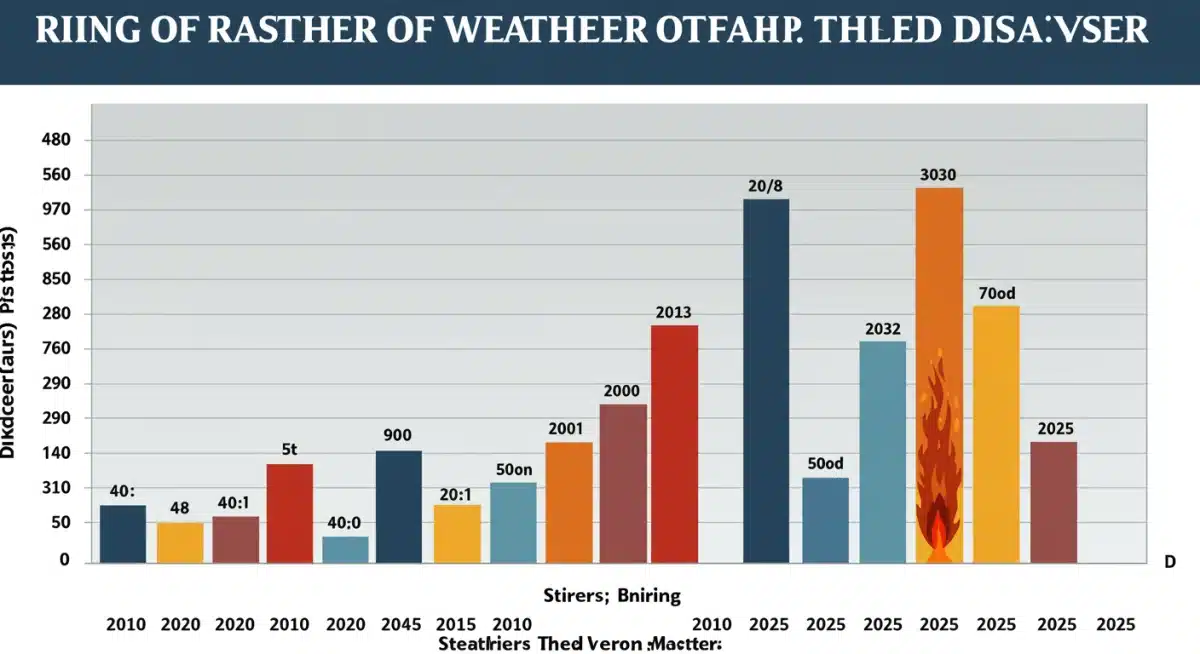
Regional Vulnerabilities Across the United States
The impacts of extreme weather are not uniformly distributed across the United States; certain regions face heightened vulnerabilities due to their geography, climate patterns, and socio-economic characteristics. Coastal states, particularly along the Gulf and Atlantic coasts, are increasingly exposed to powerful hurricanes, rising sea levels, and coastal erosion. These events threaten densely populated urban centers, critical infrastructure, and vital ecosystems.
The Western states, especially California, Oregon, and Washington, grapple with the escalating threat of wildfires, fueled by prolonged droughts, higher temperatures, and extensive forest fuel loads. These fires not only destroy property but also significantly degrade air quality across vast areas, impacting public health and economic activity. Concurrently, these regions also face water scarcity issues, exacerbating agricultural challenges and increasing the risk of hydrological imbalances.
The Midwest and Plains states are experiencing more frequent and intense rainfall, leading to widespread inland flooding that devastates agricultural communities and urban areas situated near major river systems. Tornadoes and severe thunderstorms also pose persistent threats, causing localized but intense damage. Each region’s unique climate profile necessitates tailored adaptation strategies to address its specific vulnerabilities and minimize the projected economic impact of extreme weather.
Strategies for Mitigation and Adaptation
Addressing the formidable challenge of extreme weather economic impact requires a multi-faceted approach combining both mitigation and adaptation strategies. Mitigation focuses on reducing greenhouse gas emissions to slow down climate change, while adaptation involves adjusting to the current and future effects of a changing climate. For the US, this means investing heavily in renewable energy sources, improving energy efficiency, and promoting sustainable land use practices. These efforts are crucial to curbing the long-term trajectory of extreme weather events.
On the adaptation front, enhancing infrastructure resilience is paramount. This includes building stronger seawalls and levees, elevating structures in flood-prone areas, and designing roads and bridges to withstand more extreme conditions. Early warning systems for hurricanes, floods, and wildfires must be improved and effectively communicated to ensure timely evacuations and minimize loss of life. Furthermore, nature-based solutions, such as restoring wetlands and planting urban forests, can provide natural buffers against extreme weather and offer co-benefits like improved air quality and biodiversity.
Key Adaptation Measures
- Resilient Infrastructure Investment: Upgrading and designing infrastructure to withstand future climate impacts.
- Improved Early Warning Systems: Enhancing forecasting and communication for timely public response.
- Nature-Based Solutions: Utilizing ecosystems to provide natural protection and resilience.
- Community Preparedness Programs: Empowering local communities with resources and knowledge for disaster response.
Investing in these strategies now is not just an environmental imperative but an economic necessity. Proactive measures can significantly reduce the projected $100 billion in damages, saving lives and protecting livelihoods in the long run. The cost of inaction far outweighs the cost of strategic investment.
The Role of Policy and Public-Private Partnerships
Effective response to the projected $100 billion in damages from extreme weather in 2025 hinges significantly on robust policy frameworks and dynamic public-private partnerships. Government policies play a crucial role in setting standards for resilient construction, incentivizing sustainable practices, and allocating funds for climate adaptation projects. This includes federal grants for infrastructure upgrades, revised building codes to account for future climate risks, and zoning regulations that limit development in highly vulnerable areas. Clear, consistent policy signals are essential to guide investment and ensure coordinated efforts across different levels of government.
Public-private partnerships are equally vital, leveraging the innovation and financial capacity of the private sector alongside governmental resources. For example, collaborations between insurance companies and local governments can lead to better risk assessment models and more affordable resilience measures. Technology companies can contribute advanced forecasting tools and communication platforms, while engineering firms can design and implement cutting-edge resilient infrastructure projects. These partnerships facilitate the sharing of expertise, resources, and best practices, accelerating the pace of adaptation and minimizing the overall extreme weather economic impact.
Moreover, fostering public awareness and engagement is critical. Educating communities about their specific risks and the steps they can take to prepare empowers individuals and builds collective resilience. Policies that support community-led initiatives and provide accessible resources can strengthen the social fabric and enhance local capacity to respond to and recover from extreme weather events. The combination of strong policy, strategic partnerships, and informed communities is indispensable for navigating the challenges ahead.

Anticipating the Future: Beyond 2025
While the projection of $100 billion in damages for 2025 serves as an immediate alarm, it is imperative to look beyond this single year and consider the long-term trajectory of extreme weather impacts. Climate models indicate that without aggressive global action to reduce emissions, the frequency and intensity of extreme weather events will continue to rise, potentially leading to even higher economic costs in subsequent years. This necessitates a forward-thinking approach to planning and investment, one that anticipates future risks rather than merely reacting to past damages.
Long-term planning involves integrating climate risk assessments into all major infrastructure projects, urban development plans, and economic forecasts. This proactive stance ensures that new investments are climate-resilient from conception, avoiding costly retrofits or failures down the line. Furthermore, it requires continuous research and development into new technologies and methodologies for climate adaptation, such as advanced materials that can withstand harsher conditions, or innovative agricultural practices that are more resilient to climate variability.
The conversation must also shift towards understanding the potential for cascading failures and systemic risks. A major extreme weather event can trigger multiple failures across interconnected systems—energy, water, transportation, and communication—leading to disproportionately larger economic and social disruptions. Preparing for such complex scenarios demands comprehensive risk mapping, cross-sectoral coordination, and flexible response mechanisms. The lessons learned from the extreme weather economic impact in 2025 must inform a sustained, multi-decade effort to build a truly resilient nation.
| Key Impact Area | Brief Description |
|---|---|
| Direct Damages | Physical destruction of property, infrastructure, and natural resources. |
| Indirect Costs | Business interruption, supply chain disruptions, health impacts, and lost productivity. |
| Sectoral Vulnerabilities | Agriculture, energy, real estate, and transportation face significant threats. |
| Mitigation & Adaptation | Reducing emissions and building resilient infrastructure are crucial for future stability. |
Frequently Asked Questions About Extreme Weather Economic Impact
The United States is projected to face approximately $100 billion in damages from extreme weather events in 2025. This figure accounts for direct physical damage to infrastructure and property, as well as indirect costs like business interruption and agricultural losses.
Hurricanes and tropical storms are major contributors, especially along coastal regions. Wildfires in the Western states and inland flooding from intense rainfall events across the Midwest and Plains also account for substantial portions of the economic losses.
Climate change intensifies the frequency and severity of extreme weather events. Rising global temperatures contribute to more powerful storms, prolonged droughts, and increased wildfire risks, directly amplifying the economic damages projected for 2025 and beyond.
Mitigation strategies include reducing greenhouse gas emissions through renewable energy and energy efficiency. Adaptation measures involve building resilient infrastructure, improving early warning systems, and implementing nature-based solutions to protect vulnerable communities and assets.
Vulnerable populations, including low-income communities and those in high-risk geographic areas, are often disproportionately affected. Businesses, particularly small enterprises, and critical sectors like agriculture, energy, and insurance also bear significant financial burdens.
What This Means for the Future
The projected $100 billion in climate-related damages for 2025 serves as a stark warning that the cost of inaction is rising faster than ever. This figure is not just an economic estimate—it’s a reflection of how unprepared many communities remain in the face of worsening storms, droughts, floods, and wildfires. The increasing frequency and severity of these extreme weather events highlight the urgent need to move from short-term recovery to long-term resilience.
To meet this challenge, the U.S. must embrace a comprehensive approach that includes massive investments in climate-resilient infrastructure, advanced forecasting technologies, and coordinated public-private partnerships. At the local level, communities need actionable adaptation plans that prioritize equity, sustainability, and future readiness. The success of these efforts will determine not only the nation’s economic stability but also the safety and security of millions of people.
For a detailed look at the science behind these escalating weather extremes, the NASA report on climate change and extreme weather offers valuable insights into how global warming is amplifying natural hazards. The data leaves little room for complacency—the time to strengthen our defenses and commit to climate resilience is now.
